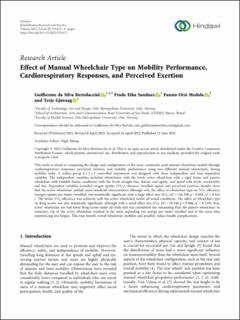| dc.contributor.author | Bertolaccini, Guilherme | |
| dc.contributor.author | Sandnes, Frode Eika | |
| dc.contributor.author | Medola, Fausto Orsi | |
| dc.contributor.author | Gjøvaag, Terje | |
| dc.date.accessioned | 2022-09-16T09:27:35Z | |
| dc.date.available | 2022-09-16T09:27:35Z | |
| dc.date.created | 2022-06-12T08:53:56Z | |
| dc.date.issued | 2022-06-11 | |
| dc.identifier.citation | Rehabilitation Research and Practice. 2022, 2022 . | en_US |
| dc.identifier.issn | 2090-2867 | |
| dc.identifier.issn | 2090-2875 | |
| dc.identifier.uri | https://hdl.handle.net/11250/3018380 | |
| dc.description.abstract | This study is aimed at comparing the design and configuration of the most commonly used manual wheelchair models through cardiorespiratory responses, perceived exertion, and mobility performance using two different manual wheelchairs, during mobility tasks. A within-group 2×3×2 controlled experiment was designed with three independent and four dependent variables. The independent variables included wheelchairs, with the levels active wheelchair with a rigid frame and passive wheelchair with foldable frame; conditions with the levels straight line, slalom, and agility; and speed with levels comfortable and fast. Dependent variables included oxygen uptake (VO2), distance travelled, speed, and perceived exertion. Results show that the active wheelchair yielded more beneficial characteristics although only the effect of wheelchair type on VO2 efficiency (oxygen uptake per meter travelled) was statistically significant with a large effect size (Fð1, 14Þ = 118:298, p < 0:001, η2 = 0:541). The better VO2 efficiency was achieved with the active wheelchair under all tested conditions. The effect of wheelchair type on Borg scores was also statistically significant, although with a small effect size (Fð1, 14Þ = 10:340, p = 0:006, η2 = 0:119); thus, active wheelchair use had lower Borg scores under all trials and was considered less exhausting than the passive wheelchair. In summary, use of the active wheelchair resulted in the users expending less energy per meter travelled and at the same time experiencing less fatigue. This may benefit overall wheelchair mobility and possibly reduce health complications. | en_US |
| dc.description.sponsorship | This work was carried out with financial support from DIKU-utforsk Project UTF under grant (number UTF-2016-long-term/10053). | en_US |
| dc.language.iso | eng | en_US |
| dc.publisher | Hindawi | en_US |
| dc.relation.ispartofseries | Rehabilitation Research and Practice;Volume 2022, Article ID 5554571 | |
| dc.rights | Navngivelse 4.0 Internasjonal | * |
| dc.rights.uri | http://creativecommons.org/licenses/by/4.0/deed.no | * |
| dc.subject | Manual wheelchairs | en_US |
| dc.subject | Wheelchair designs | en_US |
| dc.subject | Cardiorespiratory responses | en_US |
| dc.subject | Mobility performances | en_US |
| dc.subject | Exertion | en_US |
| dc.title | Effect of Manual Wheelchair Type on Mobility Performance, Cardiorespiratory Responses, and Perceived Exertion | en_US |
| dc.type | Peer reviewed | en_US |
| dc.type | Journal article | en_US |
| dc.description.version | publishedVersion | en_US |
| dc.rights.holder | © 2022 Guilherme da Silva Bertolaccini et al | en_US |
| dc.source.articlenumber | 5554571 | en_US |
| cristin.ispublished | true | |
| cristin.fulltext | original | |
| cristin.qualitycode | 1 | |
| dc.identifier.doi | https://doi.org/10.1155/2022/5554571 | |
| dc.identifier.cristin | 2031112 | |
| dc.source.journal | Rehabilitation Research and Practice | en_US |
| dc.source.volume | 2022 | en_US |
| dc.source.pagenumber | 11 | en_US |
| dc.relation.project | DIKU-utforsk: 10053 | en_US |

